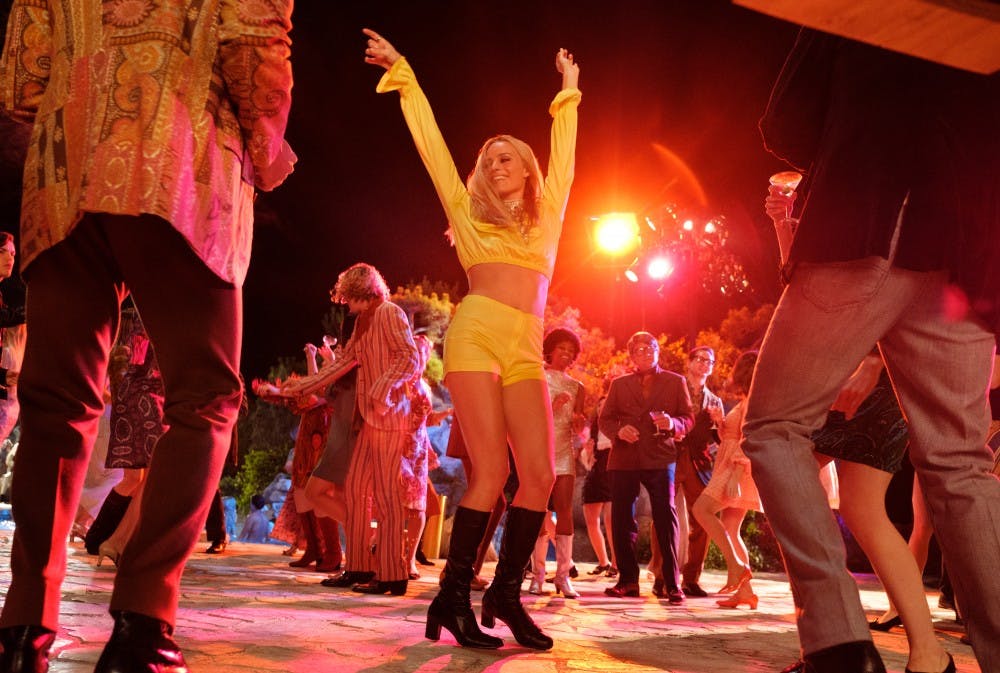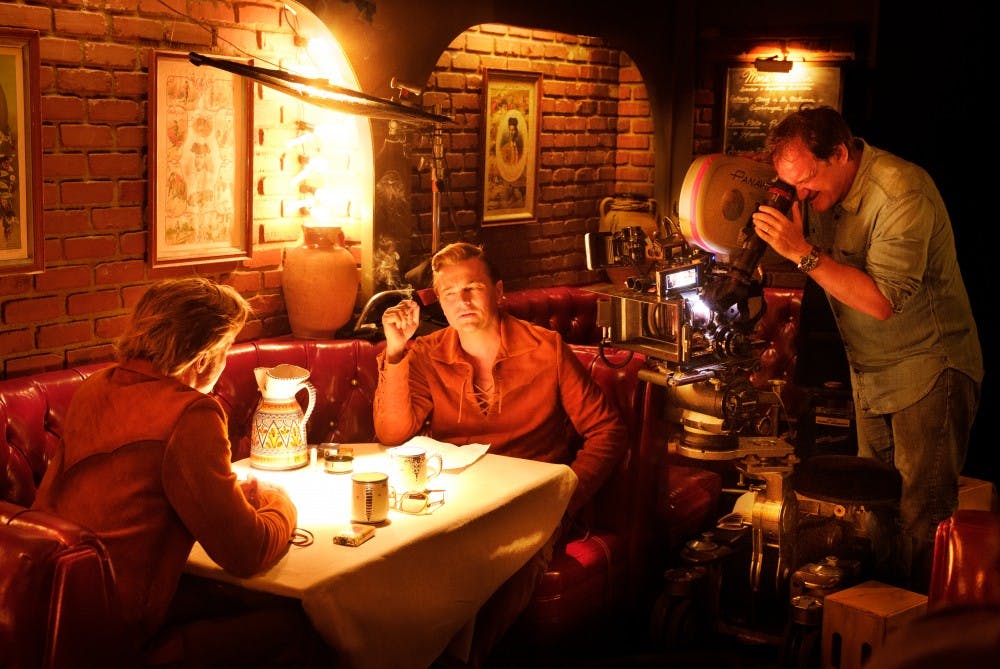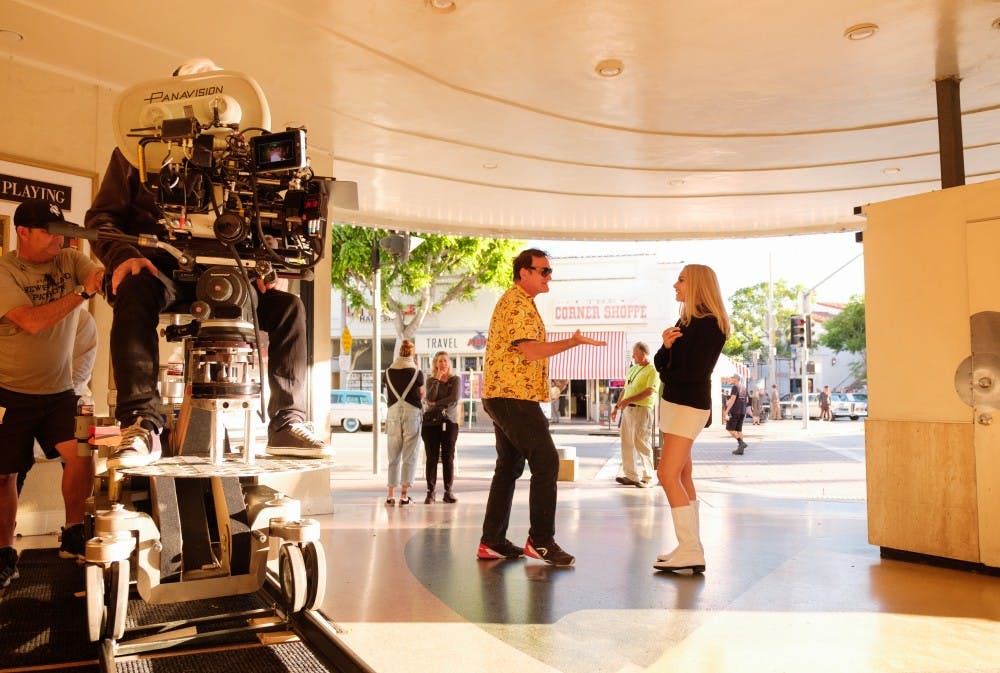Quentin Tarantino is most famous for his women. It is the picture of Uma Thurman on the poster of Pulp Fiction which is so well–known that it borders on generic; it is also her boasting the iconic yellow jumpsuit of Kill Bill that is associated prominently with Tarantino’s name. Maybe when you think of Tarantino you think of Melanie Laurent as Shoshanna escaping from her destroyed family or burning down her movie theater in Inglourious Basterds.
This habit of well–crafted women was assumed to continue into Tarantino’s ninth flick, Once Upon a Time… in Hollywood. Most current Tarantino fans—a younger generation—would not relate to the fictional, washed–up lead characters of this film, Rick Dalton (Leonardo DiCaprio) and Cliff Booth (Brad Pitt). However, a supposed deuteragonist of the movie was to be Sharon Tate (Margot Robbie), a famous victim of the Manson murders. Tate is a well–known character to current audiences for being an up–and–coming actress, marrying the famous Roman Polanski, then getting killed while pregnant in her lush home on Cielo Drive by the Manson Family at the age of 26. Tate’s story, unequivocally, is a tragic one, and this film was hyped to be a tribute to her.
Yet despite her assumed importance, Tate’s presence in the movie is slim. Most of her dialogue is inaudible, drowned out by the sound of car radios or other people speaking. Other times, she doesn’t speak at all: perhaps her best scene is in the movie theater, giggling to herself as she watches a film she acted in. Otherwise, a strange amount of her camera time is spent dancing, never saying a word, only looking beautiful and carefree.
Many critics have claimed that Tate’s relative silence in the film is on purpose—a poetic statement about how her life was cut short. However, to claim this stroke of poetic genius is to give Tarantino too much credit; Tate is visible and quiet because she’s a beautiful woman who has become such a cultural figure that giving her a personality seems impossible. The film, and Tarantino, barely appreciates Tate for who she is; outside of her scene in the theater, she does very little other than be a starlet. Tarantino does not care about anything other the aesthetics of her personage, the beauty of having such a charming young woman on Polanski's arm, the enchanting quality of a girl dancing at midnight, or the sweetness of her snoring when splayed across the bed.

Photo by Andrew Cooper | ©2019 CTMG, Inc. All Rights Reserved.
Things are often said about Tate, but she is never saying them. Most agonizing is to hear Steve McQueen (Damian Lewis) describe her backstory to another character while Tate dances around, speechlessly, at the Playboy Mansion. This feels like a perfect encapsulation of how Once Upon a Time treats Sharon Tate: she is gorgeous, silent, and marked by an interesting life story, but she is not going to be the one to tell it to us.
Tate, of course, is not the only female character in Once Upon a Time. The majority of the other women in this film comprise Charles Manson’s cult, called the Manson Family. These women, of course, committed atrocities and should be treated as such. In real life, these women murdered Sharon Tate, her three friends, and her unborn child in one evening; they also went on to kill Leno and Rosemary LaBianca before Manson was captured and arrested. In the film, while their characters are fictionalized and exaggerated, there is an element of witchcraft in the depiction of these women—young seductresses who are there to tempt Booth and any other foolish man to their horrific crimes. They wax useless philosophic and are clearly half–crazed hippies. Scenes at the Spahn Ranch, their home base, are punctuated by shots of Booth looking back to see them all watching him with unwavering, terrifying gazes.
Members of the Manson Family include Pussycat (Margaret Qualley), Squeaky Fromme (Dakota Fanning) in a role where she does surprisingly little, and the three perpetrators of the Tate murders—two of whom are women. In Tarantino’s alternate–universe, Tex (Austin Butler), Sadie (Mikey Madison), and Katie (Madisen Beaty) enter the house of Dalton and are then brutalized by Booth and his dog before they can even think of killing Tate on her estate one house over. In the director’s fashion, the violence against this trio is exaggerated, comedic, and often hard to watch, but the way the women and the men are framed show a subtler form of misogyny in Tarantino’s choices.

Photo by Andrew Cooper | ©2019 CTMG, Inc. All Rights Reserved.
Tex, who brandishes a gun and says, famously, “I came to do the Devil’s business,” gets mauled by Booth’s pitbull in a series of shaky, unclear shots: a moment of comedy is sprinkled in when the dog goes for his crotch. Katie, on the other hand, attacks Booth head–on, which leads to various extended shots of a perfectly still camera as Booth picks her up by the hair and smashes her face into the countertop multiple times. Sadie, the third perpetuator, stumbles outdoors to where Dalton lounges in the pool, where she spends the majority of the scene screaming and flailing while shooting her gun into the air. Dalton takes it upon himself to use his flamethrower from the shed to burn her to death, watching as she flounders in the water with her entire body turning to a crisp.
In my viewing, while Tex’s death got little reaction, those of Katie and Sadie resulted in some excited mumbles—particularly as Dalton brandishes his flamethrower and flames her for what feels like an endless minute until the gas runs out.
As for the end of the scene, while we get two extended shots of Katie’s mutilated face and Sadie’s charred body, Tex’s corpse remains unseen. It is clear that, while we get a laugh out of Tex’s death, the extended, gory shots for these women are the more joy–sparking.
Certainly I don’t blame Tarantino for showing the murder of these people, as they were killers themselves in real life. However, it is important to keep in mind that the entire situation in Dalton’s house, including Dalton himself, is fabricated. Tarantino wrote that Katie would survive for much longer and have to get her face smashed in for two minutes, and Sadie would get graphically burned on screen. The text is fiction, and the fiction leans towards the enjoyment of female torture.
Once Upon a Time… in Hollywood does not just do its women wrong—it wants us to laugh at it for brutalizing them. Claiming Tarantino to be a poetic crafter of female characters is a grave misinterpretation; to do so is to praise a director who clearly only uses women as a footstool in his excessive, dramatic torture–porn.

